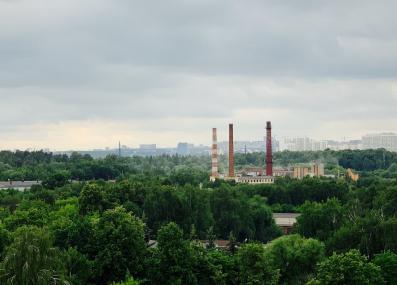Have a question?
How much carbon dioxide would we have to remove from the air to counteract climate change?
If we relied on carbon removal alone, we would need to sequester around 20 billion tons of CO2 a year to balance out our emissions—an incredibly tall order.
October 26, 2023
Emerging technologies like direct air capture, which pulls carbon dioxide (CO2) straight from the atmosphere, can remove some of the climate-warming greenhouse gases humanity puts into the air. They offer the tantalizing possibility that humans could halt climate change without major changes to our way of life: we simply pull all the greenhouse gases we put into the atmosphere back out.
But this is a nearly impossible task, says Charles Harvey, an MIT professor of civil and environmental engineering who has studied both natural and technological ways to take CO2 out of the atmosphere. Removing CO2 is one of the hardest and most expensive ways we could address climate change—far more difficult than simply emitting less carbon in the first place.
Humanity produces a staggering amount of CO2: more than 35 billion tons of it each year.1 The Earth soaks up roughly half of that, Harvey says, when it moves carbon dioxide from the atmosphere into the ocean, plants, soils, and other natural “carbon sinks.” To fully cancel out our carbon emissions, humanity would have to capture and store the other half, or nearly 20 billion tons each year.
That only accounts for current emissions. Human activities have already vastly increased the amount of CO2 in the atmosphere: from less than 300 parts per million before the Industrial Revolution to around 420 today.2 To “turn back the clock” on climate change, we would need to capture today’s emissions plus this enormous backlog. To reach 350 parts per million, the level of atmospheric carbon dioxide in 1988, humans would need to remove more than 500 billion tons. To get the atmosphere back to where it was before humans began to burn fossil fuels en masse would mean catching and storing more than 900 billion tons.
Today’s approaches can capture only a tiny fraction of what’s needed: around 2 billion tons of carbon dioxide annually, according to one recent study.3 Nearly all of this removal is accomplished through longstanding, nature-based strategies such as replanting forests, rather than via advanced technologies. And there are good reasons to doubt that new technological forms of carbon capture—such as direct air capture, BECCS (bioenergy with carbon capture and storage), biochar, and enhanced rock weathering—will add much to that number anytime soon, Harvey says. It would take so much money and energy to capture enough carbon dioxide to make a difference that we’d be better off putting the effort toward moving away from fossil fuels, the main source of our planet-warming emissions.
“It's so much harder to capture carbon than it is to just not emit it to begin with,” says Harvey. “When your bathtub is overflowing, you don't reach for the gold-plated mop—you just turn off the faucet.”
Land use is one major problem with high-tech carbon capture. It would take an enormous number of direct air capture facilities, for example, to process enough air to make a difference. It would also take a huge number of wind and solar farms to power those facilities, Harvey says, and those need land, too. BECCS and old-fashioned forest restoration also require an enormous amount of land to grow plants that absorb CO2 from the air. But land is a finite resource. The carbon-removing potential of these projects would be limited by how many square miles they could use.
The second big challenge is cost. Again, consider direct air capture: it takes a lot of energy to pull air into the system and power the chemical reactions that separate carbon dioxide from the other constituents of air, and that energy costs money. “It just costs energy to separate things,” Harvey says. “There's a thermodynamic limit that you can't beat.”
In fact, says Harvey, the energy demands of direct air capture are so great that “canceling out” humanity’s emissions this way would take more energy than we’re getting from burning fossil fuels in the first place. “You'd have to build way more renewables than we need to stop burning fossil fuels altogether. You don't want to spend enormous amounts of money doing that when you could use the money to go over to renewables.”
These challenges don’t mean there’s no place for technologies that draw carbon out of the atmosphere, Harvey says. Numerous reports have argued that it’s impossible for the world to meet its climate goals without a big increase in how much CO2 is removed from the atmosphere.4 But this should be seen as a (very challenging) addition to ramping down our carbon emissions—not an easy shortcut to stopping or reversing climate change.
Thank you to Dawn Ertl of Los Angeles, California, for the question. You can submit your own question to Ask MIT Climate here.
1 Friedlingstein, Pierre, et al., "Global Carbon Budget 2022." Earth System Science Data, Volume 14, Issue 11, 2022, doi:10.5194/essd-14-4811-2022.
2 NASA Global Climate Change: Vital Signs of the Planet: Carbon Dioxide. Updated September 2023.
3 Smith, S. M., Geden, O., Nemet, G., Gidden, M., Lamb, W. F., Powis, C., Bellamy, R., Callaghan, M., Cowie, A., Cox, E., Fuss, S., Gasser, T., Grassi, G., Greene, J., Lück, S., Mohan, A., Müller-Hansen, F., Peters, G., Pratama, Y., Repke, T., Riahi, K., Schenuit, F., Steinhauser, J., Strefler, J., Valenzuela, J. M., and Minx, J. C., "The State of Carbon Dioxide Removal -
1st Edition." 2023.
4 Intergovernmental Panel on Climate Change: Climate Change 2022: Mitigation of Climate Change. Contribution of Working Group III to the Sixth Assessment Report of the Intergovernmental Panel on Climate Change. "Chapter 3: Mitigation pathways compatible with long-term goals." Riahi, K., R. Schaeffer, J. Arango, K. Calvin, C. Guivarch, T. Hasegawa, K. Jiang, E. Kriegler, R. Matthews, G.P. Peters, A. Rao, S. Robertson, A.M. Sebbit, J. Steinberger, M. Tavoni, D.P. van Vuuren. Cambridge University Press, 2022, doi:10.1017/9781009157926.005.









